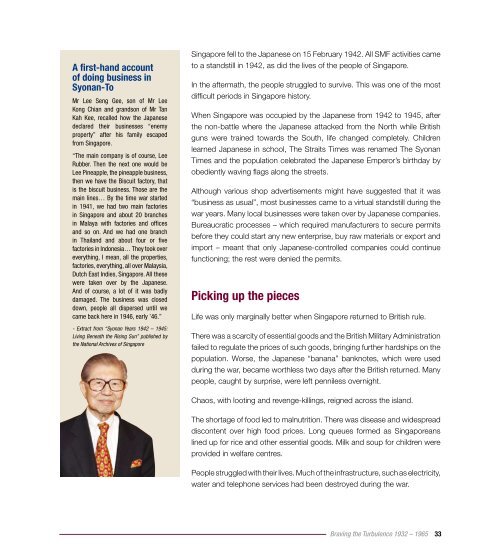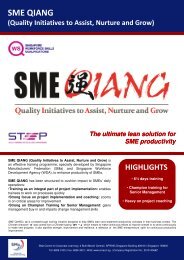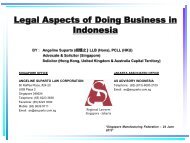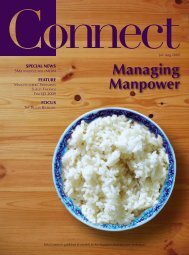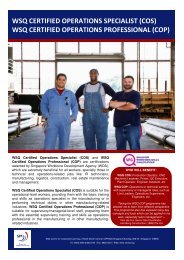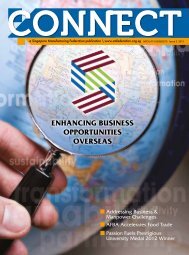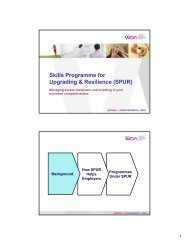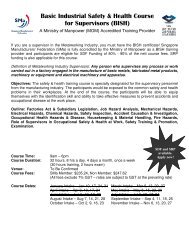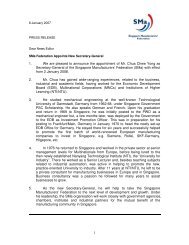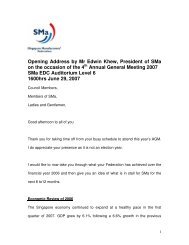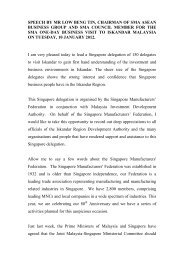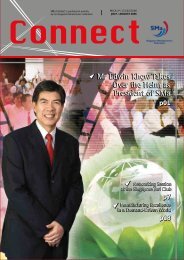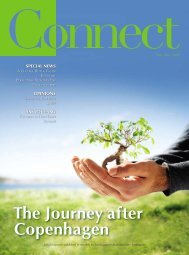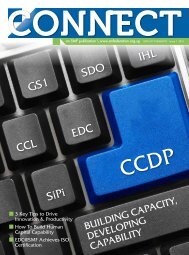80th Anniversary Commemorative Book - Singapore Manufacturing ...
80th Anniversary Commemorative Book - Singapore Manufacturing ...
80th Anniversary Commemorative Book - Singapore Manufacturing ...
Create successful ePaper yourself
Turn your PDF publications into a flip-book with our unique Google optimized e-Paper software.
A first-hand accountof doing business inSyonan-ToMr Lee Seng Gee, son of Mr LeeKong Chian and grandson of Mr TanKah Kee, recalled how the Japanesedeclared their businesses “enemyproperty” after his family escapedfrom <strong>Singapore</strong>.“The main company is of course, LeeRubber. Then the next one would beLee Pineapple, the pineapple business,then we have the Biscuit factory, thatis the biscuit business. Those are themain lines… By the time war startedin 1941, we had two main factoriesin <strong>Singapore</strong> and about 20 branchesin Malaya with factories and officesand so on. And we had one branchin Thailand and about four or fivefactories in Indonesia… They took overeverything, I mean, all the properties,factories, everything, all over Malaysia,Dutch East Indies, <strong>Singapore</strong>. All thesewere taken over by the Japanese.And of course, a lot of it was badlydamaged. The business was closeddown, people all dispersed until wecame back here in 1946, early ’46.”- Extract from “Syonan Years 1942 – 1945:Living Beneath the Rising Sun” published bythe National Archives of <strong>Singapore</strong><strong>Singapore</strong> fell to the Japanese on 15 February 1942. All SMF activities cameto a standstill in 1942, as did the lives of the people of <strong>Singapore</strong>.In the aftermath, the people struggled to survive. This was one of the mostdifficult periods in <strong>Singapore</strong> history.When <strong>Singapore</strong> was occupied by the Japanese from 1942 to 1945, afterthe non-battle where the Japanese attacked from the North while Britishguns were trained towards the South, life changed completely. Childrenlearned Japanese in school, The Straits Times was renamed The SyonanTimes and the population celebrated the Japanese Emperor’s birthday byobediently waving flags along the streets.Although various shop advertisements might have suggested that it was“business as usual”, most businesses came to a virtual standstill during thewar years. Many local businesses were taken over by Japanese companies.Bureaucratic processes – which required manufacturers to secure permitsbefore they could start any new enterprise, buy raw materials or export andimport – meant that only Japanese-controlled companies could continuefunctioning; the rest were denied the permits.Picking up the piecesLife was only marginally better when <strong>Singapore</strong> returned to British rule.There was a scarcity of essential goods and the British Military Administrationfailed to regulate the prices of such goods, bringing further hardships on thepopulation. Worse, the Japanese “banana” banknotes, which were usedduring the war, became worthless two days after the British returned. Manypeople, caught by surprise, were left penniless overnight.Chaos, with looting and revenge-killings, reigned across the island.The shortage of food led to malnutrition. There was disease and widespreaddiscontent over high food prices. Long queues formed as <strong>Singapore</strong>anslined up for rice and other essential goods. Milk and soup for children wereprovided in welfare centres.People struggled with their lives. Much of the infrastructure, such as electricity,water and telephone services had been destroyed during the war.Braving the Turbulence 1932 – 1965 33


